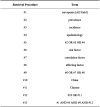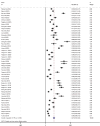The prevalence of sarcopenia and risk factors in the older adult in China: a systematic review and meta-analysis
- PMID: 39161853
- PMCID: PMC11331796
- DOI: 10.3389/fpubh.2024.1415398
The prevalence of sarcopenia and risk factors in the older adult in China: a systematic review and meta-analysis
Abstract
Background: Understanding the epidemiological information of a certain disease is the first step in related prevention and control work. This article aims to understand the prevalence and associated risk factors of sarcopenia among the older adult (≥60 years old) in China and to provide an evidence-based basis for early identification, management, and prevention of sarcopenia patients.
Methods: We searched seven databases: CNKI, Wanfang, VIP, PubMed, Web of Science, Embase, and Cochrane Library databases from the establishment of the database until January 31, 2024. The Quality evaluation criteria of cross-sectional studies recommended by the Agency for Healthcare Research and Quality (AHRQ) were used for literature quality evaluation. Stata 18.0 software was used for statistical analysis.
Results: We finally included 45 studies, involving a total of 37,571 cases. After statistical analysis, we found that the prevalence of sarcopenia among the older adult in China was 20.7% [95% CI (18.3, 23.0%)]. The results of subgroup analysis suggest that: ① According to gender, the prevalence rate of sarcopenia in women (21.6%) is higher than that in men (19.2%); ② According to age, the prevalence rate of older adult people aged ≥80 (45.4%) was the highest, followed by 70-79 (27.2%) and 60-69 (15.7%). ③ According to region, the prevalence rate of the older adult in the south (21.7%) is higher than that in the north (19.0%); ④ According to the time of publication, the prevalence of sarcopenia among the older adult in China has increased (from 19.2% in 2014-2018 to 21.4% in 2019-2024); ⑤ According to the diagnostic criteria, the detection rate of AWGS (2019) is higher than that of AWGS (2014) (24.5% vs. 19.3%). Finally, aging, low BMI, low leg circumference, smoking, depression, osteoporosis, malnutrition and malnutrition risk are all risk factors for sarcopenia among the older adult in China.
Conclusion: The prevalence of sarcopenia in the older adult in China was higher (20.7%), which should be paid attention to by relevant health authorities. In addition, aging, low BMI, low calf circumference, smoking, depression, osteoporosis, malnutrition and malnutrition risk are risk factors for the development of sarcopenia in the older adult in China. For these high-risk populations, early identification, prevention, and intervention can be carried out to delay the occurrence and progression of sarcopenia.
Keywords: Chinese; meta-analysis; older adult; prevalence; risk factors; sarcopenia.
Copyright © 2024 Meng, He, Fu, Zhang, Tong, Li, Zhang, Shi and Liu.
Conflict of interest statement
The authors declare that the research was conducted in the absence of any commercial or financial relationships that could be construed as a potential conflict of interest.
Figures
References
Publication types
MeSH terms
LinkOut - more resources
Full Text Sources




